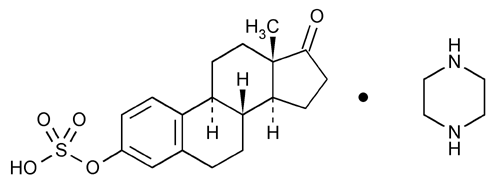Estropipate
Estra-1,3,5(10)-trien-17-one, 3-(sulfooxy)-, compd. with piperazine (1:1).
Estrone hydrogen sulfate compound with piperazine (1:1)
» Estropipate contains not less than 97.0 percent and not more than 103.0 percent of C18H22O5S·C4H10N2, calculated on the dried basis.
Packaging and storage—
Preserve in tight containers.
Identification,
Infrared Absorption  197K
197K .
.
Loss on drying  731
731 —
Dry it at 105
—
Dry it at 105 for 1 hour: it loses not more than 1.0% of its weight.
for 1 hour: it loses not more than 1.0% of its weight.
Residue on ignition  281
281 :
not more than 0.5%.
:
not more than 0.5%.
Free estrone—
Stock impurity standard preparation—
Weigh accurately 25.0 mg of USP Estrone RS into a 100-mL volumetric flask, dilute with spectrophotometric-grade methanol to volume, and sonicate to achieve complete solution.
Impurity standard preparation—
Weigh accurately 25.0 mg of USP Estropipate RS into a 25-mL volumetric flask, add 2.0 mL of Stock impurity standard preparation, dilute with spectrophotometric-grade methanol to volume, and sonicate to achieve complete solution.
Standard preparation—
Weigh accurately 25.0 mg of USP Estropipate RS into a 25-mL volumetric flask, dilute with spectrophotometric-grade methanol to volume, and sonicate to achieve complete solution.
Test preparation—
Using a portion of Estropipate, accurately weighed, prepare as directed under Standard preparation.
Mobile phase—
Mix 650 mL of 0.025 M potassium dihydrogen phosphate with 350 mL of spectrophotometric-grade acetonitrile. Filter the solution through a membrane filter having a porosity of 1 µm or less, and degas at a pressure of less than 100 mm of mercury until no further bubbles appear. The concentration of acetonitrile may be varied to meet system suitability requirements and to provide a suitable elution time for all components.
Chromatographic system—
Typically, a high-pressure liquid chromatograph, operated at room temperature, is fitted with a 30-cm × 3.9-mm stainless steel column that contains packing L1. The mobile phase is maintained at a pressure and flow rate (approximately 1.5 mL per minute) capable of giving the required resolution (see System suitability test) and a suitable elution time. An UV detector that monitors absorption at a wavelength of 213 nm is used with a recorder adjusted such that approximately 0.04 absorbance unit gives a full-scale reading.
System suitability test—
Chromatograph two injections of the Impurity standard preparation, and determine that after the injection front the small peak (estrone) after the major peak does not differ in peak response between the duplicate injections by more than 4%. Also determine that the small peak after the major component has a retention time relative to the major component of approximately 5.5. (For a particular column, resolution may be increased by decreasing the amount of acetonitrile in the Mobile phase.)
Procedure—
Inject separately 5.0-µL portions of the Standard preparation, the Impurity standard preparation, and the Test preparation into the high-pressure liquid chromatograph by means of a suitable sampling valve or high-pressure microsyringe. Measure the peak responses for the estrone peak relative to the estropipate peak obtained with the Standard preparation, the Impurity standard preparation, and the Test preparation. Calculate the percentage of free estrone taken by the formula:
2.5(C/W)(HU / HS)
in which HU and HS are the measured peak heights of the impurity (estrone) in the Test preparation and the Impurity standard preparation corrected for the peak height of estrone in the Standard preparation, respectively, W is the weight, in mg, of estropipate in the Test preparation, and C is the concentration, in µg per mL, of USP Estrone RS in the Impurity standard preparation. Not more than 2.0% is found.
Assay—
Standard preparation—
Prepare as directed under Free estrone.
Assay preparation—
Prepare as directed for Test preparation under Free estrone.
Chromatographic system—
Use the same system as in test for Free estrone. Adjust the recorder so that approximately 0.4 absorbance unit gives a full-scale reading.
System suitability test—
Chromatograph two injections of the Standard preparation, and determine that only one major peak is observed after the injection front. The peak responses between the duplicate injections for the major peak do not differ by more than 3%.
Procedure—
Inject 5.0 µL of the Assay preparation and the Standard preparation into the high-pressure liquid chromatograph by means of a suitable sampling valve or high-pressure microsyringe. Measure the peak heights for the respective estropipate peak (it is actually an estrone sulfate peak) obtained with the Assay preparation and the Standard preparation. Calculate the quantity, in mg, of C18H22O5S·C4H10N2 in the portion of Estropipate taken by the formula:
25C(HU / HS)
in which HU and HS are the peak heights obtained with the Assay preparation and the Standard preparation, respectively, and C is the concentration, in mg per mL, of USP Estropipate RS in the Standard preparation.
Auxiliary Information—
Please check for your question in the FAQs before contacting USP.
Chromatographic Column—
| Topic/Question | Contact | Expert Committee |
| Monograph | Daniel K. Bempong, Ph.D.
Senior Scientist 1-301-816-8143 |
(MDPS05) Monograph Development-Pulmonary and Steroids |
| Reference Standards | Lili Wang, Technical Services Scientist 1-301-816-8129 RSTech@usp.org |
USP32–NF27 Page 2315
Chromatographic columns text is not derived from, and not part of, USP 32 or NF 27.
